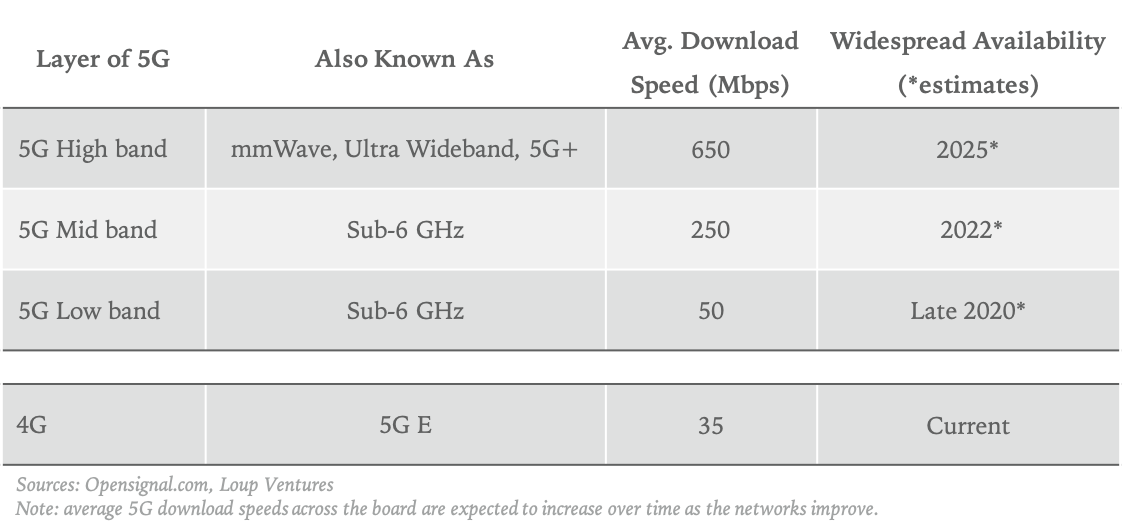Over the next decade, we believe 5G will be a transformative force because it will allow users to leverage data in the cloud for real-time computing, opening the door for an array of new technologies and businesses. That said, not all 5G is created equal, which has led to marketing noise from carriers regarding 5G performance and deployment. In the end, both consumers and businesses are left unsure as to the timing of the 5G transformation.
To get a more realistic sense of this timing, we’ve taken a step back and constructed a 5G rollout roadmap, which gives us a better sense of when 5G will impact consumer purchasing decisions and spur next-generation technologies such as IoT, wireless VR, and autonomous vehicles.
5G 101
We think of 5G as a three-layered cake.

Low band is marketing noise, yet still a necessary layer of the 5G cake
What is it: The bottom layer of the cake is low band 5G, which is about 40% faster than 4G and the slowest 5G offering. It provides the best range of any 5G, making it ideal for rural areas. To date, when you hear carriers advertise “nationwide 5G coverage,” they’re referring to low band 5G.
Availability: End of 2020.
Why it’s important: Given its continuous coverage in rural areas, low band 5G will be part of a comprehensive, long-term 5G infrastructure. That said, with average speeds just ~1.4x faster than 4G, low band 5G is only a marginal improvement and likely won’t drive consumer adoption of 5G devices, e.g., iPhone 12.
Mid band is consumer upgrade 5G
What is it: The second layer is mid band 5G, which offers a combination of long-range and download speeds around 500% faster than low band 5G.
Availability: 2022. We estimate that mid band 5G will be widely available, defined as 75% of the US population having consistent access to it, in 2022. To date, only T-Mobile has made material progress with mid band rollout among carriers. At their 2020 Q2 earnings call, the company said it wants to build out its mid band network “over the next few years.” FCC public auctions for mid band spectrum in December 2020 and 2021 are expected to accelerate Verizon and AT&T’s mid band 5G offerings over the next two years.
Why it’s important: Given the large speed increase, which will enable faster video streaming, gaming, and better off-device storage among other things, we believe mid band 5G will compel users to upgrade their devices as part of a multi-year upgrade cycle that will extend through 2024. That said, we think consumer demand for new 5G-capable devices, such as the iPhone 12 set to be released this fall, will be soft through 2021.
High band is transformative 5G
What is it: The top layer of the cake is high band 5G, and it’s usually what people think of when they envision 5G as a revolutionary technology. It is composed of high-frequency waves that offer average download speeds around 260% greater than mid band 5G. That said, it provides the worst range of any 5G, largely confining it to metro areas and large public venues that have developed infrastructure and a high density of mobile users. Even then, high band 5G can be easily obstructed by physical objects such as walls, trees, and windows.
Availability: 2025. We estimate that widespread high band 5G, defined as 75% of the US population in metro areas having consistent access, will be available in 2025. To date, two carriers have deployed high band 5G in select zones of about 35 cities. The pandemic has put in doubt whether high band deployment is currently worth the capital expenditure, as the areas in which high band 5G is most effective are empty due to COVID-19 restrictions.
Why it’s important: Once high band 5G is widely available in metro areas, we believe it will begin to power the next generation of transformative technology use cases.
